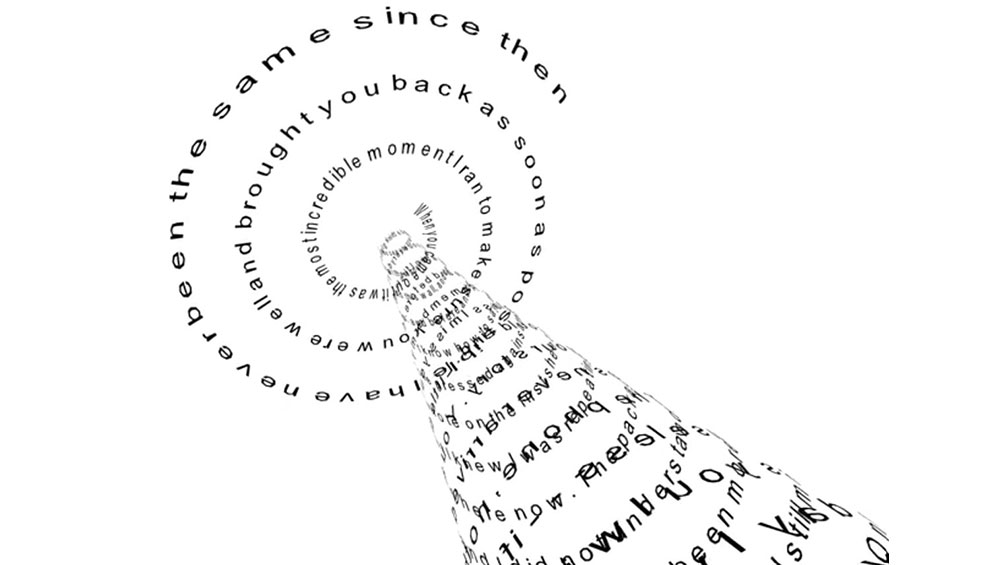
Eduardo Kac, Letter, still, 1996.
HEK (House of Electronic Arts), Basel
3 October – 28 November 2024
by CATHERINE MASON
“Once more … I advance, once more, along these corridors, through these salons, these galleries, into this construction …” Alain Robbe-Grillet, 1961
This excerpt from Robbe-Grillet’s screenplay for the 1961 French new wave film L'Année Dernière à Marienbad was reproduced in the artist Liliane Lijn’s catalogue of her 1993 Poem Machines show at London’s Victoria & Albert Museum. In Lijn’s catalogue it is printed in the original French; I have translated it here using Google’s artificial intelligence (AI) tool. This quote calls to mind a contained space in which to practise or construct art. (L'Année Dernière à Marienbad is in fact set in the confined space of a hotel.) A progression through time of ideas, a repeating physical and psychological advancement that seems necessary to translate ideas from the human mind into the visual, Lijn’s poetic works of the 1960s, like the film, explore reality, time, identity and the nature of the human mind.
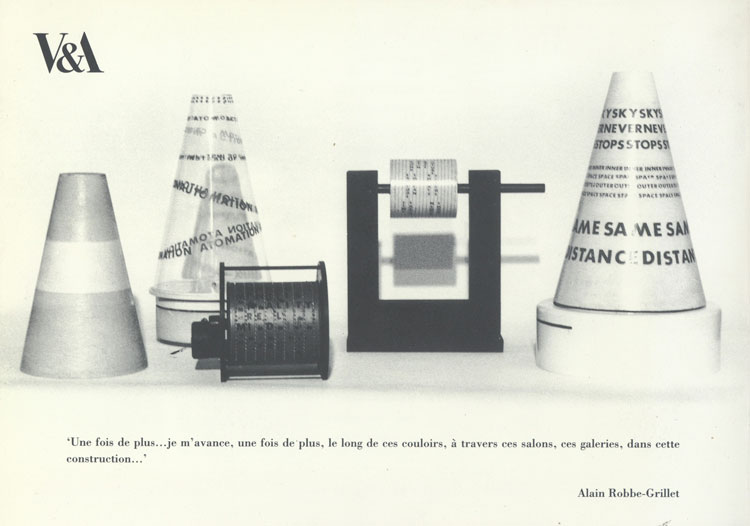
Liliane Lijn Catalogue from the Victoria & Albert Museum, 1993.
These thoughts are with me as I approach Material Poetry, a new group exhibition of contemporary digital poetry presented by HEK (House of Electronic Arts) Basel and Synthesis Gallery, curated by Giorgio Vitale. This exhibition is also set in a defined space - a virtual salon created on the internet. Accessible at any time, without having to travel to Basel, it is an experiment in the materiality of language and its ability to transform thoughts into images both in the mind and visually, using today’s digital technologies.
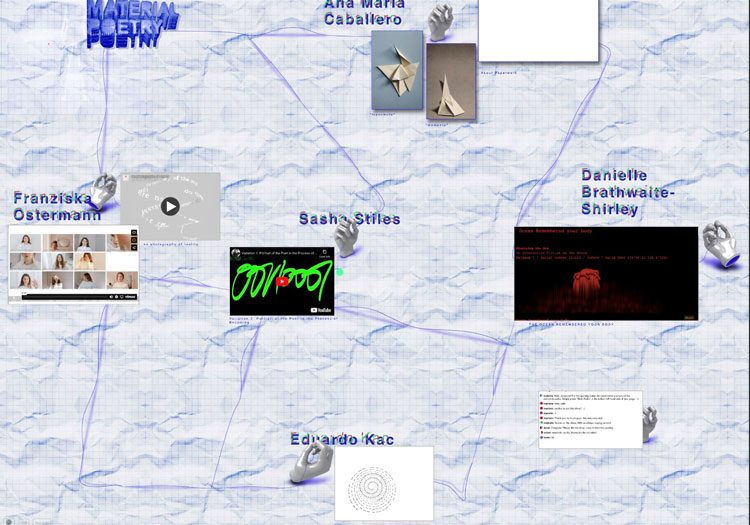
Material Poetry, virtual exhibition at HEK, screenshot, 2024.
The exhibition considers new media poetry through the work of five artists: Ana María Caballero, Danielle Brathwaite-Shirley, Eduardo Kac, Franziska Ostermann and Sasha Stiles. This is a continuation of a line of practice that includes kinetic art, constructivism and the concrete poetry movement – all of which can be seen in Lijn’s Poem Machines, first exhibited in Paris in 1963. (Lijn’s recent exhibition in Munich, was reviewed by Studio International.) Lijn, probably the first person to make electronically based poem machines, was searching for a new language. As she explained to Studio International in 2014: “My interest was in language from a very early age, but that language was constantly shifting and changing […] words are made up of letters, and letters are made up of lines, so why not use words?” Printed words using Letraset were applied to cylinders that spin at high speeds (using motors) until they blur and vibrate. Lijn told the Tate: “When I made Poem Machines my intention was to explode both prose and poetry, remembering their origin in vibration.” Her later Poem-cones had text carved into white rotating cones, lit from within. This makes poetry a form of visual expression, as Lijn explained: “I wanted people to see sound.” Today, poetry can encompass a variety of computerised techniques, employing language, imagery, moving image, sound and interaction.
Material Poetry continues this tradition of visual kinetic poetry, with a selection of artists working with what might be considered humanity’s newest languages – generative systems driven by AI and Virtual Reality (VR). Like Lijn, these poets investigate the intersection of human and machine, shifting the way viewers encounter poetry by giving it a visual presence, albeit one that exists in a virtual space. Here, the works are presented on a background resembling a crumpled piece of graph paper, encouraging the viewer to discover new approaches to poetry.
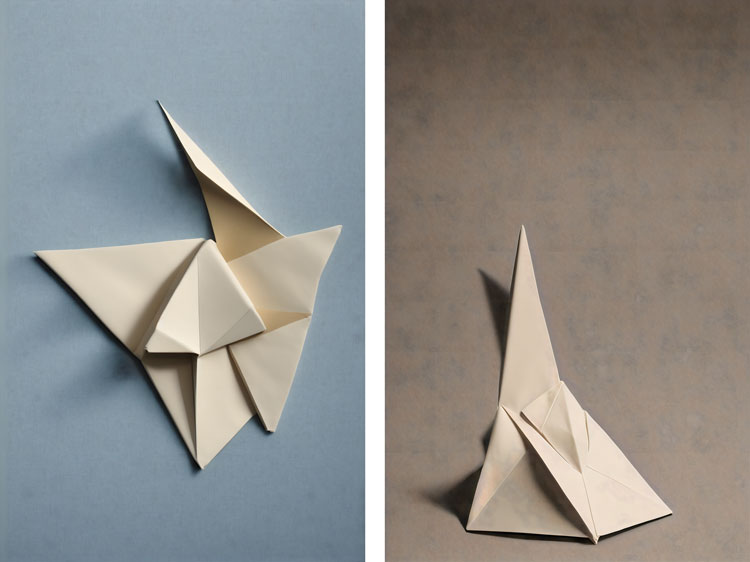
Ana María Caballero, Paperwork: Transmute, 2024 (left); Paperwork: Memento, 2024.
Reflecting the materiality of poetry and its role in transmitting memory, Caballero’s work is rooted in the personal details of her life. One of her prevalent themes, motherhood, challenges notions that present female sacrifice as a virtue. By using her lived day-to-day experiences, she hopes her work will be universally relatable and give voice to what is left unsaid in the home. Created from an AI-generated system, her spoken word digital poems create immersive experiences. Paperwork, shown here, generates digital “paper” sculptures that exist virtually, constructed from data gathered from audience reactions to public performances of her poetry. The finished works, therefore, invoke a sense of place from elements of their origin in cities such as Los Angeles, Bogotá and Valencia where she has performed.
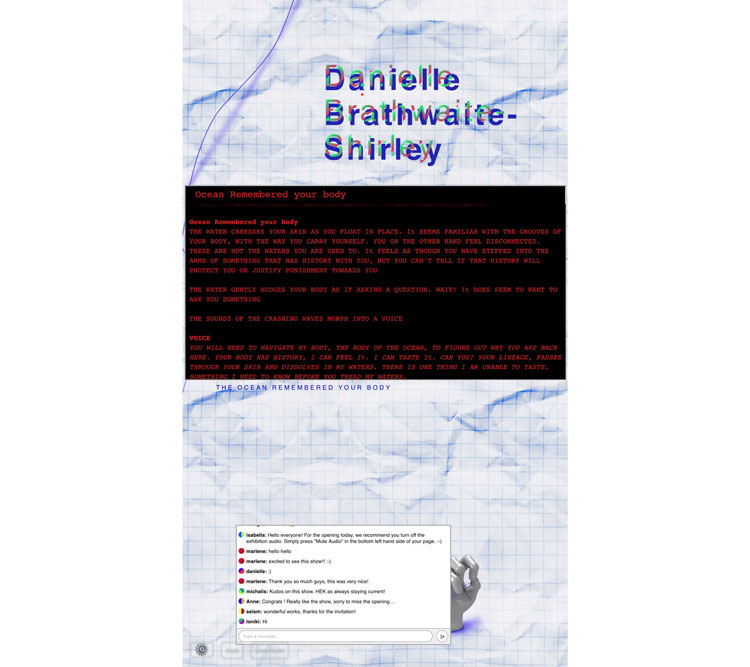
Danielle Brathwaite-Shirley, Material Poetry exhibition 2024, screenshot.
Brathwaite-Shirley uses custom-coded video games as an artistic medium. This encourages participants to get involved in the art process and question decisions made during play. In The Ocean Remembered Your Body, players navigate a text-based video game that ponders identity and memory. The ocean serves as a metaphor and a physical space, drawing on the artist’s personal history of Black trans experience and honouring the narratives of marginalised bodies. Inspired by early text-based adventure games, the piece encourages players to engage their imaginations, reconstructing the world from their own experiences and histories.
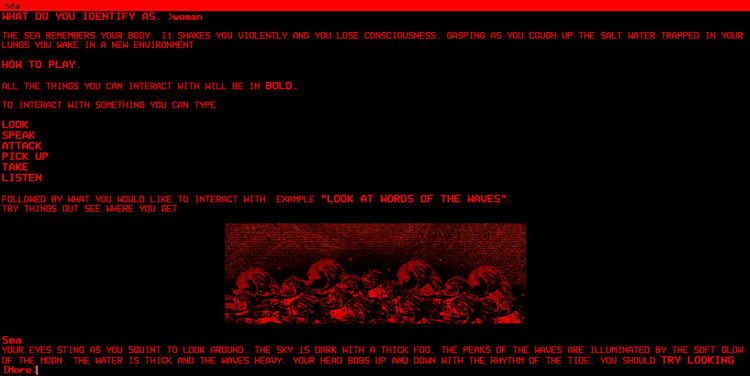
Danielle Brathwaite-Shirley, The Ocean Remembered Your Body, screenshot, 2021.
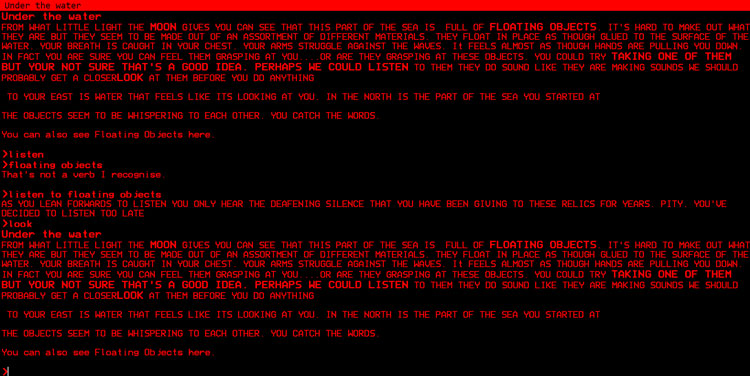
Danielle Brathwaite-Shirley, The Ocean Remembered Your Body, screenshot, 2021.
Kac’s Letter was originally created in 1996 as a VR experience and is here presented as video documentation of an interactive reading experience. Two spiralling cones made of text rotate in three-dimensional space, drawing the viewer into an immersive reading experience. Composed of fragments of letters referencing moments of birth and death in the poet’s family, the poem’s dynamic form is at once is converging and diverging. Letter is an exploration of the spatial possibilities of a language made visible.
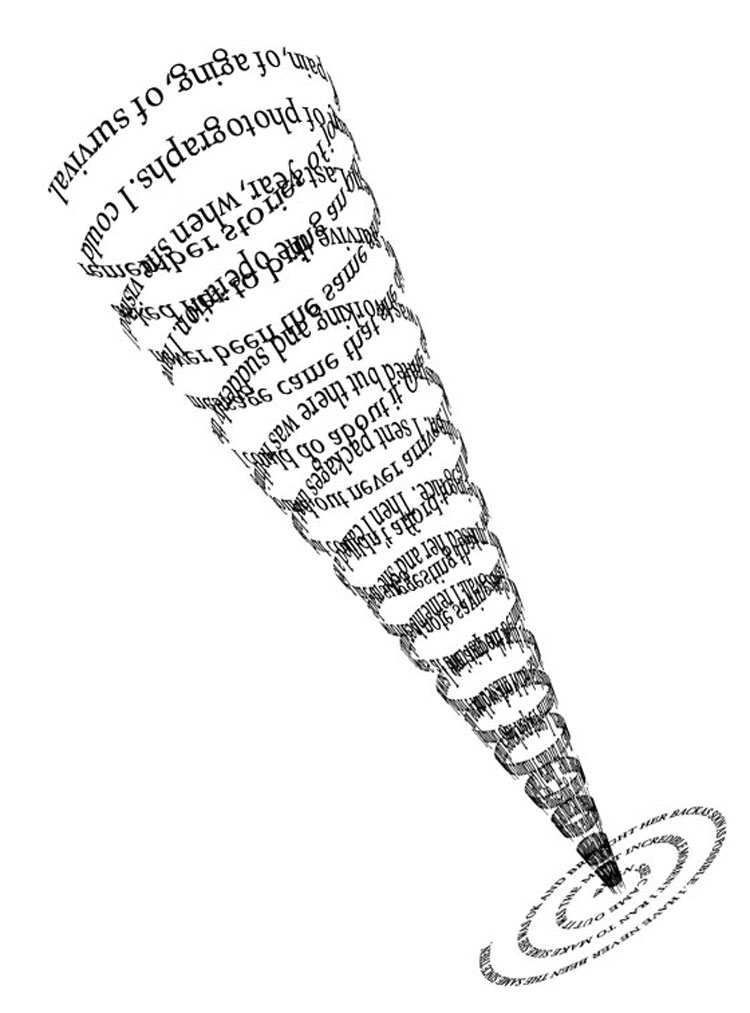
Eduardo Kac, Letter, still, 1996.
Likewise, Ostermann’s piece No Photographs of Reality challenges traditional notions of text, space and perception. This three-dimensional poem is conceived as a verse sculpture, she says, “inviting viewers to explore the physicality of language in a virtual environment”. The lines of text are in motion and can be turned and examined from various angles, the legibility of the text shifting and changing. This, the artist says, “mimics the way our understanding of reality can alter based on perspective. By playing with the idea of readability, you might see the back of a word, or catch a phrase from an unusual angle. It's a reminder that meaning isn't always straightforward or immediate.”
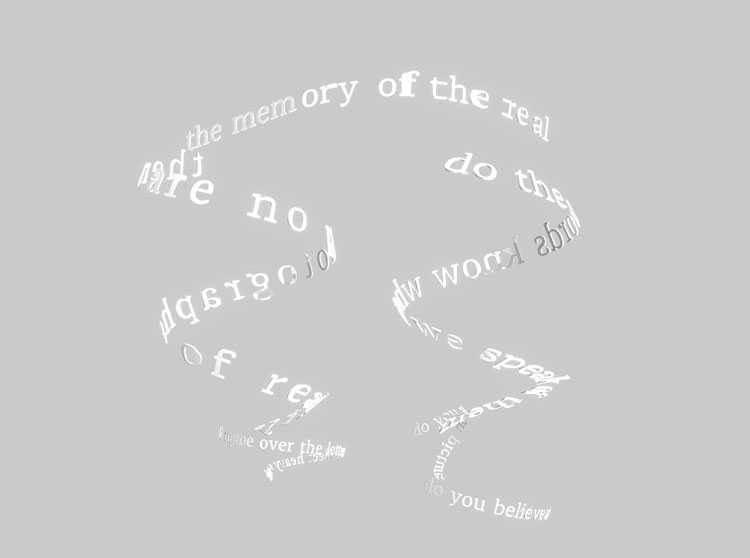
Franziska Ostermann, No Photographs of Reality, still, 2024.
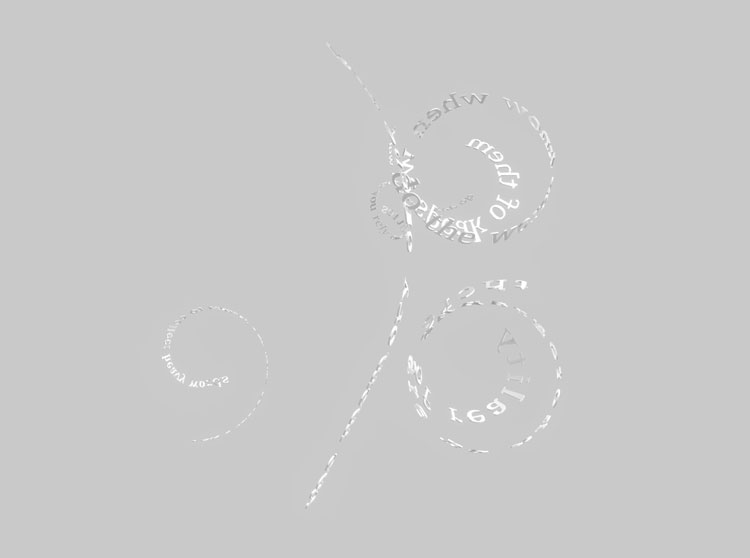
Franziska Ostermann, No Photographs of Reality, still, 2024.
Ostermann’s second work Can You Hear Me? seems more critical of the technology and reminds us that the Covid-19 pandemic accelerated the increase in digitality that was already underway in society. This work involves the artist staging a Zoom call with versions of herself, each version attempting unsuccessfully to connect with the others. Familiar to all of us who struggle to connect in online meetings these days, phrases such as “Can you hear me?”, “Wait a minute … what about now?” are like modern-day aphorisms, spoken into the ether.
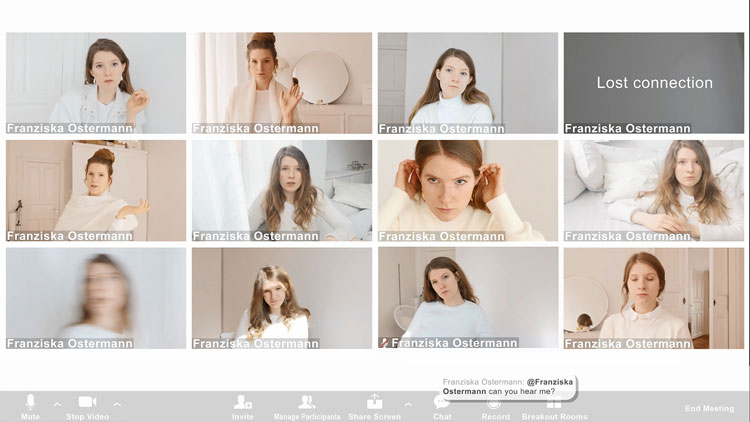
Franziska Ostermann, Can You Hear Me?, still, 2021.
Finally, Stiles’ Cursive Binary: Portrait of the Poet (Variation 1) is a layered, generative, moving image work that merges poetry with AI and digital language. Stiles’s practice investigates nonhuman intelligence and the ethos of consciousness to examine questions of what it means to be human when humanity is almost superseded by computational advances. She uses various digital tools, including hand-coding and AI text generation tools – her AI poetry alter ego, Technelegy, has been fine-tuned using custom data sets. The visuals are supplied by the artist’s Cursive Binary language, developed with Technelegy, and are in the tradition of asemic poetry. The artist says this facilitates “transhuman communication”. Stiles further explains: “I've been shaped in some fundamental ways by the dystopian view of Al in culture, the presentation of Al as a supernatural, mysterious force that won’t ever go back into the box.” Her work questions the future of authorship and identity in a posthuman world.
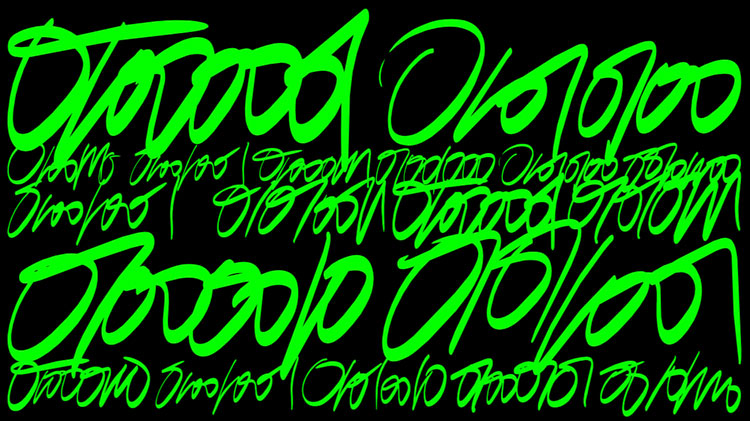
Sasha Stiles, Cursive Binary: Portrait of the Poet (Variation 1), still, 2024.
.jpg)
Sasha Stiles, Cursive Binary: Portrait of the Poet (Variation 1), still, 2024.
Material Poetry shows that via the digital medium, poetry can become a living artefact, multifaceted and dynamic. Words and visual art are vessels of meaning and combining them creates a dialogue between language and form. These works, like Lijn’s physical Poem Machines before them, riff on the interplay between text and images, between the tangible and the conceptual. By giving words weight, movement, and dimensionality through digital art, the line is blurred between the abstract nature of language and the concrete world it often describes.
Poems as visual representations of ideas or thoughts have advanced in huge ways recently. web 3.0, the next iteration of the internet, has been a natural jump for the evolution, production and display of poetry. As Caballero says: “The life of a published poem is too brief.” Caballero and Stiles were among the founders of theVERSEverse in 2021, which presents and sells poems as works of art and enables poets and writers to delve into web 3.0. In this way the modernist trajectory of poetry and text-based art continues into the 21st-century, expanding audiences and bringing new life and relevance to this art form.